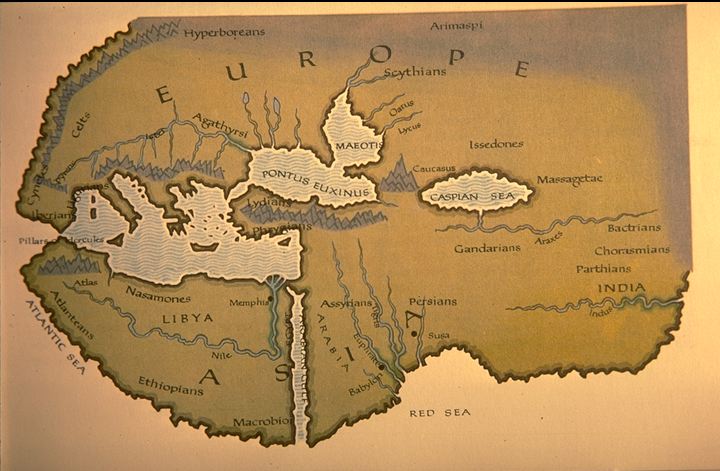Ancient city of Jadu, one of oldest Berber communities in Libya's western Nafusa mountains. twitpic.com/5h1yz4 #Libya
In 3000 BC the Nile flowed through southern Libya
on way to Atlas mountains and Atarantes; Atlantis; Atjgila Atlantis on the map, lies between Augila and the Atarantes ... is reached from Ehypt through the Nasamones aka Libya.

"Island of Atlantis" translated as the "island of Atlas"
One does not need to be a Greek scholar to recognize the word "Atlantis" in the above Greek text (line 5, 3rd word from the left). Many of my colleagues insist that the phrase should be translated "the sea of Atlas" instead of the Atlantis Sea. While it is true that Atlantis is an inflected form of Atlas, these very same colleagues have never suggested that when Plato speaks of the "island of Atlantis" it would be more properly translated as the "island of Atlas". The island and the ocean were called "Atlantis" because they were named after Atlas (which is what the name "Atlantis" means). The point here, which cannot be gainsaid, is that Atlantis was known before Plato--so well-known that the sea outside Gibraltar was commonly called the Atlantis Sea in Herodotus' time. It had acquired that name because Atlantis had once occupied that area. We carry the same tradition down when we refer to that same body of water as the Atlantic. While in Europe, I noticed that their maps label the same ocean "Atlantischer," preserving the word "Atlantis" intact.
In 3000BC the Libyans’ live in the nation Nasamones
NASAMONES AND MAKAI. And from Hesperides there is a great gulf, which has
name Syrtis, and, so to say, as one guesses approximately, of 5,000 stades. In width it is, from Hesperides to Neapolis [New City] on the other side, a voyage of three days and three nights. And there lives around it the Libyans’ nation Nasamones as far as the inner end on the left. And to these are adjacent the Libyans’ nation, beside the Syrtis as far as the mouth of the Syrtis, of the Makai. And as one sails into the Syrtis from Hesperides, there are Herakles’ Banks; and adjacent to these are Drepanon; the three Pontiai islands; then among these some are called Leukai [White Islands]. And in the most hollow part of the Syrtis, in the inner end, Philainos’s altars; a seaport; Ammon’s halous* of the Syrtis. From this, living beside the Syrtis, the Makai winter upon the sea, shutting in their animals, and in the summer, with the waters receding, they drive away their animals into the interior, inland, with themselves. And after the Syrtis, outside the Syrtis, is a find settlement and city, which has the name Kinyps; and it is deserted. And from Neapolis the distance to the Syrtis is 80 stades [on every side]: and under it is the river Kinyps, and an island is below towards the river. And the depth of the Syrtis inside Hesperides towards Philainos’s altars, to the inner end of the gulf, voyage of 3 days and nights; and width from Kinyps river towards the Leukai islands, voyage of four days and four nights." -- Skylax
